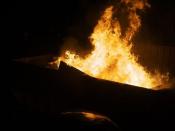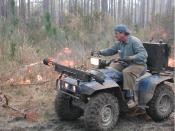INTRODUCTION
Fire has been a factor in the formation and maintenance of our forests for centuries (Lamprey, 1974). This has occurred from natural sources such as lightning as well as from people. This combination has resulted in our current forest compositions and some of the attitudes the public holds on fire today.
Prescribed burning is often mentioned as a tool to prevent wildfires. Little data exists to support this premise. The purpose of this research was to show that prescribed burning is an effective long-term wildfire prevention tool. The study used a descriptive historical research methodology. The research questions to be answered are:
1. Does prescribed burning reduce the size and
intensity of wildfires?
2. Are the effects of prescribed burning as a
wildfire prevention tool measurable?
3. Does the use of prescribed burning eliminate
the threat of wildfire?
A study was done on the prescribed burning and wildfire data in selected areas within the Orlando District of the Florida Division of Forestry.
The results indicate that a sustained program of prescribed burning reduces the number of wildfires, acres burned, and average acres per wildfire. Prescribed burning did not eliminate the threat of wildfire, only ameliorated its effects. The recommendations of the study included further research to document and quantify the benefits of prescribed burning, inform the fire service and the public on the use of prescribed fire for wildfire prevention, and promote the general use of prescribed burning by landowners and land managers. (USDA).
BACKGROUND & SIGNIFICANCE
From the first Native Americans--Paleo-Indians who used fire in hunting mastodons and woolly mammoths - to present-day foresters who employ a variety of management regimes, human manipulation of our 737 million acres of forests dates back some 12,000 years. (Mobley, Jackson, Balmer, Ruziska, and Hough, 1978). Indeed, it was largely by...


